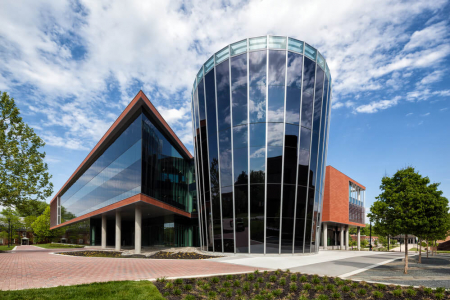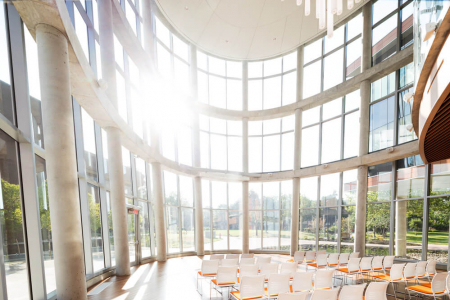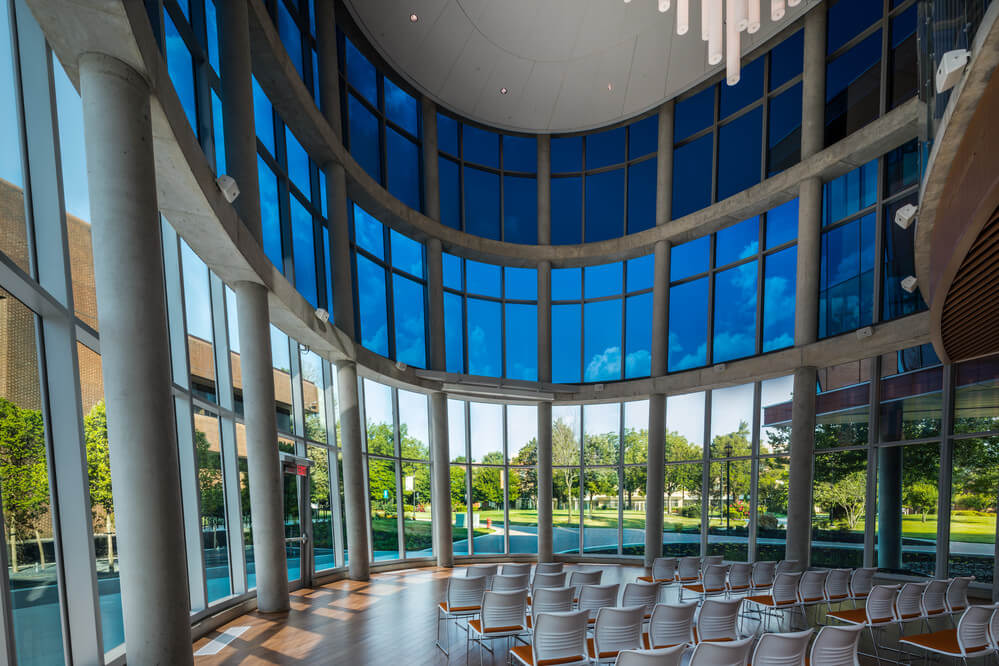The Story In Brief
Stephen Selkowitz, recently retired as department head and a senior advisor for building science at Lawrence Berkeley National Laboratory, is one of the world’s foremost experts on windows and building façades. His conversation with EPRI Journal reveals that the potential for emerging window technologies to transform power grid operations is much larger than most realize. He points to the significant reductions in energy consumption and peak demand that are possible. Utilities can play an important role in this window revolution.

EJ: Explain how today’s windows and building façades result in significant energy losses. Where are the opportunities for energy savings?
Selkowitz: Each year in the United States, windows are responsible for about 30 percent of the energy used to heat and cool buildings—about 4.1 quads—at a cost of $50 billion. This consumption is a result of thermal heat losses and gains across windows, air leakage, and transmission of solar heat into buildings.
In the summer, conventional windows allow heat from sunlight to enter buildings, increasing cooling load. This solar heat gain tends to be the major driver of summer afternoon cooling peaks—usually even a bigger driver than air temperature. In the winter, windows are poor insulators compared to walls and allow heat to leak from buildings, increasing heating loads on HVAC systems. Better window technologies offer numerous energy savings opportunities and improved comfort. High-performance windows can minimize solar heat gain in the summer to reduce cooling loads, admit solar heat and insulate against heat loss in the winter, reduce energy consumption for artificial lighting during the daytime, and reduce a building’s peak heating and cooling load.
Windows are unique building elements. Unlike heating, cooling, and lighting systems where the typical design strategy is to reduce energy use to lower levels, windows have the potential to be zero net energy or even net-positive energy. For instance, in northern climates in winter, if windows reduce thermal losses and capture solar gains, they can become net-positive energy.
When people analyze building energy use and inefficiencies, they typically focus on heating, cooling, and lighting systems. These analyses are not often done for windows or building envelopes because they don’t consume energy directly. That’s why people sometimes overlook the building envelope when assessing energy-related investments. Coming up with the right metrics for windows and envelopes, understanding how to quantify savings potential, and justifying necessary investments have always been a challenge. Unlike HVAC and lighting, which have relatively short lifespans, building envelopes are expected to last the life of the building, making it especially important to design them right at the beginning.
EJ: How can highly insulating windows help reduce energy consumption?
Selkowitz: Before the 1970s in the U.S., most windows utilized a single pane of glass. With the oil crisis of the 1970s and dramatic increases in energy costs, double-glazed insulating windows were adopted more widely. These consist of two panes of glass with air in between, but they were still 10 times “leakier” than insulated walls. To improve their thermal performance without a radical redesign, two novel technologies were added: low-e coatings and argon gas instead of air between the panes. These changes doubled the window’s insulating value at a modest additional cost. Today, this technology accounts for about 85% of all residential and commercial window sales. It has reduced heating and cooling loads and since its introduction has saved $150 billion in energy costs just in homes compared to conventional double-pane windows. Yet modeling shows that there’s a lot of room for improvement. These windows are still responsible for billions of dollars in energy lost each year.
In northern Europe, three-paned windows known as triple glazing technology are now widely used. But U.S. window companies have not gone from double-glazed to triple-glazed because that would make the glass unit wider and heavier, requiring a redesign of the window sash and frame—which in the U.S. is traditionally much thinner than in Europe. This is very expensive and risky for the manufacturers, who see uncertain markets for these innovations.
Berkeley Lab has developed a novel triple-glazed window that offers a solution to this problem. A third pane of very thin glass is inserted between the two panes of a double-glazed, low-e window, a second low-e coating is applied, and in the gaps between the panes argon is replaced with krypton, which is more insulating. The window manufacturers don’t have to change anything else about the double-paned window. They can use their existing sash and frame. These design changes increase the glass weight by only 10% while doubling the window’s insulating value. Depending on climate and orientation, this new window can be close to net-positive energy.
Interestingly, Berkeley Lab patented this window in the 1990s, but at the time, the thin glass sheets needed for the middle layer were unavailable. When cell phone makers initially introduced these sheets, they were too expensive. Since then, the flat screen TV industry has advanced the thin glass production technology needed to bring those costs down—to the point where it is possible to make affordable triple-glazed windows. We’re now working across the supply chain to optimize each component and testing prototypes in the lab and field with two window companies—Andersen and Alpen.
This window should be suitable for large-scale manufacturing with a modest increase in production costs. In California, there’s an opening for large-scale, near-term market adoption. The state’s 2019 residential building code requires a much more highly insulated wall. Installing about 300 square feet of triple-glazed windows gives a building the same rating as installing about 2,000 square feet of the highly insulated wall. Many builders may opt for the windows, assuming they can purchase and install them at a cost lower than the extra wall insulation. There’s also an opportunity here for utility rebate programs to subsidize at least the initial market entry of these products in California and other jurisdictions where code changes are underway.
EJ: What are ‘smart’ windows?
Selkowitz: Smart or dynamic windows are another big area of technology development. They have glazings that change their optical properties to admit more or less heat and light from the sun. Typically, they darken and become more absorptive so less sunlight is transmitted. There are three types. Photochromic glazings respond to certain levels of visible sunlight, thermochromic glazings respond to temperature levels, and electrochromic glazings change when a voltage is applied.
Thermochromic windows are commercially available today. When the glass heats above a certain temperature, it will switch from transparent to dark. It works well in some applications, but not so well in others because the switching temperature is fixed—so the windows can’t be controlled by the building’s energy management system. If you’re a utility that’s planning a demand response event, you want the windows in a particular location to switch at a particular time to reduce the cooling load. You don’t want to wait or be dependent on a change triggered by temperature.
Electrochromic windows are the main player in the smart window field. They are effective at reducing glare and solar heat gain and are well suited to building energy management systems because timing the changes can be controlled with electrical signals. You can continuously optimize the glass properties to reduce cooling load, address peaks, and support smart grid operations.
Electrochromic windows have been commercially available for less than 10 years. They’re still well under 1% of the window market but growing quickly. In addition to high costs, a big challenge is how to control and integrate them with building lighting and HVAC systems and demand response controls. Who decides to send the signal to darken the windows, and what drives that decision? A building manager has to consider the window’s impacts on heating, cooling, and lighting loads as well as the workers’ visual requirements. Typically, the manager wants to solve the visual comfort problem first because the cost of the workers in the building is far more than the energy costs. Should the windows let more sunlight through so that electric lighting can be dimmed, or should they let less sunlight through in order to reduce cooling load? As new buildings and retrofits shift to more efficient LEDs, building managers will probably err on the side of minimizing the cooling load since lighting loads are becoming smaller.
Grid operators also have particular needs that may or may not be aligned with the needs of the building managers and workers. There’s a lot of discussion in the window industry about these challenges right now. My view is that real-time optimization of smart windows is too complex to be handled by a human being. It should be automated, but with a local user override option. The solution will require cooperation among window manufacturers and HVAC companies along with input from utilities on their changing grid landscape. Berkeley Lab has demonstrated that using a smart controller to manage electrochromic windows, dimmable lights, solar, and battery storage can flatten and minimize loads during the afternoon and early evening peak periods.
A related important area of smart window technology is integrated façades that control and redirect daylight in commercial buildings. Automated, motorized shading devices can block excessive sunlight and regulate glare. Skylights allow sunlight to penetrate deep into low-rise buildings, and emerging products can direct daylight two to three times deeper than conventional solutions. Artificial lighting can be automatically dimmed in response to changing daylight. In the winter, these components can help maximize solar heat gain and minimize heating energy losses. And in the summer, they can help reduce cooling loads. Control systems are still needed to manage the façade components along with HVAC and lighting systems to keep the indoor environment comfortable and reduce energy consumption.
EJ: There’s been a lot of buzz about windows that can generate power from sunlight. What’s your perspective on the technology?
Selkowitz: Power-generating windows have emerged in the last five years and are an exciting addition to the available window options. In the first generation, conventional solar cells were incorporated into glazing, letting some light through and absorbing and converting the remainder to electricity. The newest products provide unobstructed views and daylight. They absorb solar energy in the non-visible parts of the spectrum and convert it to electricity. There are half a dozen startups working on the technology.
We’ve tested some of these products, and they work. But all of them share a few challenges. Each window needs to be wired to a building electrical network to deliver power. Vertical windows on a building façade receive less solar energy and may be obstructed by other buildings or trees. The see-through products yield just half the power of conventional solar cells. The ultimate impact on the building energy use will depend on how these challenges are resolved.
EJ: What are the barriers to innovation in window technology?
Selkowitz: Innovation is challenged by the fragmented nature of the window industry. The window makers don’t make glass, and the glass makers don’t make windows. There are many other companies that make key components: hardware, sash and frame, weather-stripping, and sealants. A complex supply chain is involved in assembling, delivering, and installing units. This can lead to a chicken-and-egg problem. For example, if you ask the glass makers why they don’t make a more advanced glazing, they may say that the window makers don’t see a need for it. And if you ask the window makers why they don’t want it, they may say that it would be too expensive from the glass supplier and that the market doesn’t want it. Contrast this with the aircraft and automotive industries, where one entity manages innovation across the entire supply chain from start to finish, including customer sales.
EJ: What are the implications of widespread adoption of advanced window and façade technologies for grid operations?
Selkowitz: The potential impacts are significant. Windows are a big contributor to cooling loads, particularly in hot climates and in office buildings with a lot of glass. If you can dynamically control light and heat at the façade and make windows zero net energy or net-positive energy, you can have a big effect on peak demand during the hottest few days of the year. They can significantly impact load shape on essentially every day of the year that there’s a cooling load.
There’s big emerging potential for heating as well. For example, most of the older homes in California are heated with natural gas. If the state replaces its gas heating infrastructure with electric to help meet its decarbonization targets, utilities may end up with a winter-morning heating peak. Triple-glazed windows could play an important role in reducing those new winter peaks.
Berkeley Lab has modeled the potential energy savings if all windows were converted to various advanced window technologies. For U.S. residential buildings, we found that triple-glazed windows can reduce annual heating and cooling energy use by 1.64 quads. If you make the windows even more insulating and add dynamic solar heat gain control, the potential annual savings is 2.25 quads. In this case, windows would enable zero net heating energy consumption, while cooling energy consumption would be reduced by 80%.
For commercial buildings, we found that highly insulating, dynamic windows could save 1.62 quads for heating and cooling each year. With integrated façades that use daylight, you can reduce artificial lighting use to save even more and make buildings net-positive energy.
EJ: What role can utilities play in advancing these technologies?
Selkowitz: There are three things utilities can do. First, there’s a big need for field demonstrations to monitor and objectively document the performance of window technologies. Utilities can play a crucial role in making those happen. These will probably uncover technical challenges that need to be addressed. Utility-sponsored demonstrations can examine the impacts of advanced windows on load shapes, summer cooling peaks, winter heating peaks, and HVAC system sizing. Successful demonstrations build confidence among building owners and should help utilities with strategic planning.
Number two, utilities can help these technologies bridge the gap between proof-of-concept in the field and standard practice through rebate or other financial incentive programs. With more utility programs supporting these new technologies, other window companies will be more likely to step on the bandwagon and start producing them.
Number three, to maximize market potential, smart window systems must be able to easily communicate and integrate with a wide range of HVAC and lighting systems. Today, each design is tediously optimized and integrated with a “plug and pray” approach. This increases costs and risk and reduces interest in adoption among building owners. Utilities could be a powerful force for standardizing communication protocols by tying adoption of these protocols to rebates and incentives.
EPRI Delves into the Practical Details of Advanced Window Applications
EPRI’s Advanced Buildings Program includes research on window technologies and other components of building envelopes, with a focus on cost-effective application and integration in buildings. As part of field demonstrations with utilities, builders, and developers, EPRI researchers are examining the costs and challenges of large-scale adoption of advanced windows and emerging window technologies. This includes the practical details of installing them in high-performance buildings and integrating them with lighting, HVAC, and other building systems.
“As with most customer technologies, when assessing the market potential for a new window technology, you need to evaluate more than just the technology,” said EPRI Technical Executive Ram Narayanamurthy, who manages the Advanced Buildings Program. “The overall application costs significantly impact adoption. A new smart window, for instance, may have a reasonable capital cost, but what are the additional integration costs that fall on the builder, and what are the barriers to customer acceptance? Builders may coordinate with multiple contractors to install the new product, or customers may not like how it looks. These are the types of issues that EPRI is investigating to understand how to advance market adoption of these technologies.”
One recent EPRI study modeled the costs and market potential of many smart window glazing combinations in different climates and building types. Research plans include investigating potential impacts of advanced windows on peak load, load shapes, energy consumption, and other aspects of grid operations. EPRI-led field demonstrations in advanced energy communities with high-performance buildings can offer insights on such impacts.









